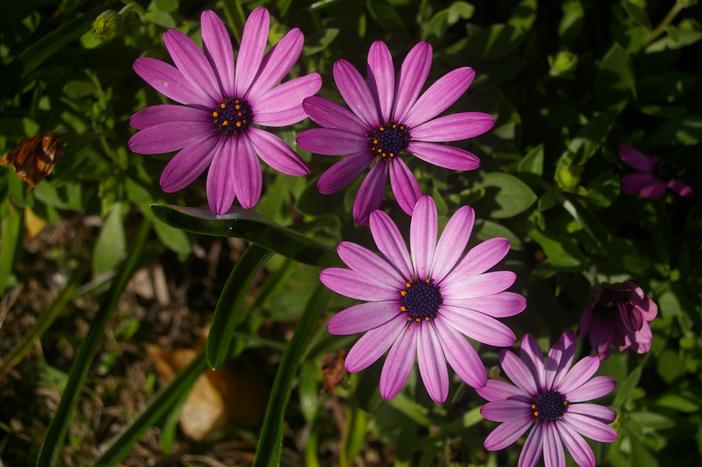Shrubby Daisybush
(Osteospermum fruticosum)
Shrubby Daisybush (Osteospermum fruticosum)
/
/

John Robert McPherson
CC BY-SA 4.0
Image By:
John Robert McPherson
Recorded By:
Copyright:
CC BY-SA 4.0
Copyright Notice:
Photo by: John Robert McPherson | License Type: CC BY-SA 4.0 | License URL: https://creativecommons.org/licenses/by-sa/4.0 | Uploader: John Robert McPherson | Publisher: Wikipedia Commons



























Estimated Native Range
Summary
Osteospermum fruticosum, commonly known as Shrubby Daisybush, is an evergreen semi-succulent perennial herb native to the coastal regions and rocky slopes of South Africa. It typically grows between 6 and 12 inches (15 and 30 cm) tall and can spread 4 to 6 feet (1.2 to 1.8 m) wide. The plant forms a dense, mounded ground cover with fleshy, gray-green leaves. Its daisy-like flowers, which bloom mainly in spring and fall, feature a dark center disk surrounded by petals that range in color from deep purple to white. Some hybrid cultivars offer pale yellow flowers. The blooms are quite showy and attract pollinators such as bees and butterflies.
Shrubby Daisybush is valued for its drought tolerance and low maintenance, making it a popular choice for rock gardens, coastal landscapes, and as a ground cover in sunny areas. It thrives in well-drained sandy soils and requires little water once established, preferring full sun to light shade. While it is generally disease-resistant, it can suffer from root rot if overwatered. In regions with mild winters, it provides year-round interest. Gardeners should be cautious about its potential invasiveness when grown outside its native range and check local regulations before planting.CC BY-SA 4.0
Shrubby Daisybush is valued for its drought tolerance and low maintenance, making it a popular choice for rock gardens, coastal landscapes, and as a ground cover in sunny areas. It thrives in well-drained sandy soils and requires little water once established, preferring full sun to light shade. While it is generally disease-resistant, it can suffer from root rot if overwatered. In regions with mild winters, it provides year-round interest. Gardeners should be cautious about its potential invasiveness when grown outside its native range and check local regulations before planting.CC BY-SA 4.0
Plant Description
- Plant Type: Herb
- Height: 0.5-1 feet
- Width: 4-6 feet
- Growth Rate: Rapid, Moderate
- Flower Color: Purple, White
- Flowering Season: Spring, Summer, Fall
- Leaf Retention: Evergreen
Growth Requirements
- Sun: Full Sun, Part Shade
- Water: Low
- Drainage: Medium, Fast
Common Uses
Bee Garden, Butterfly Garden, Drought Tolerant, Fire Resistant, Groundcover, Low Maintenance, Showy Flowers, Street Planting
Natural Habitat
Coastal regions and rocky slopes of South Africa
Other Names
Common Names: Trailing African Daisy, Dimorphotheca
Scientific Names: , Osteospermum fruticosum, Dimorphotheca fruticosa, Calendula fruticosa, Blaxium decumbens, Calendula diffusa, Osteospermum riparium,
GBIF Accepted Name: Osteospermum fruticosum (L.) Norl.